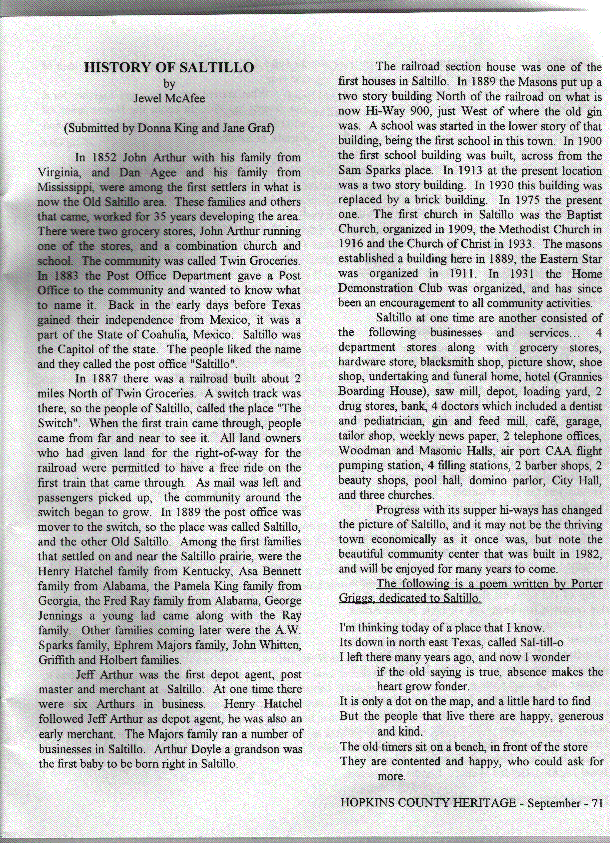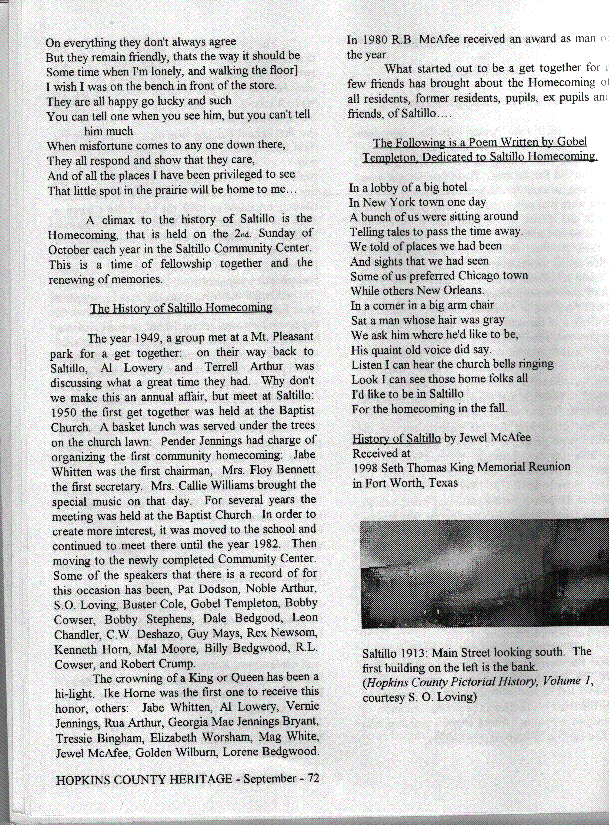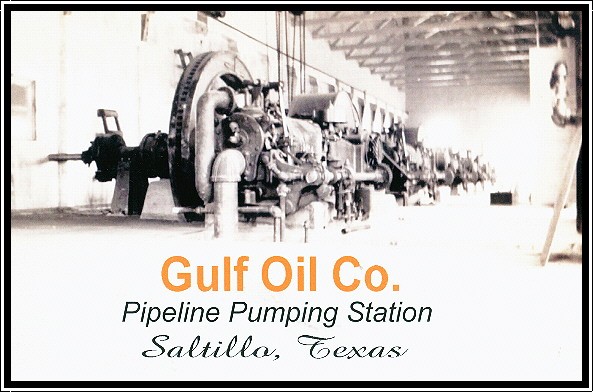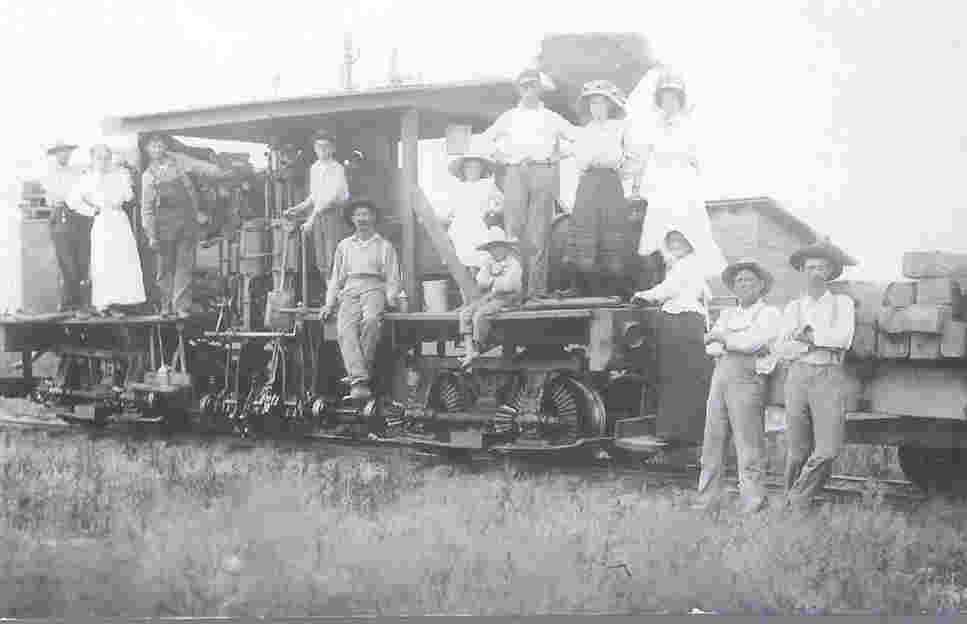The Saltillo Pump Station
In 1907 the Gulf Pipeline Company constructed a line between Sour Lake, TX and Sapulpa, OK so that crude oil could be transported from Glenn Pool to refineries on the Gulf Coast of Texas. The Gulf Oil Corporation owned a majority interest in Gulf Pipe Line. The line extended to a length of 480 miles. The total cost of construction was $5,000,000, and the line's capacity was 13,500 barrels daily.
The law of eminent domain applied to pipe lines in Texas and Oklahoma, therefore, no property owner could prevent the line from crossing his/her land. Most of the construction workers were men who lived on or near the farms through which the line passed. The men used teams of horses or teams of mules to transport the pipes to the sites, and they dug the ditches by hand. Working in gangs, the men used tongs to screw the pipes together. Each worker was paid $2.50 for a day's work, which could mean twelve to fourteen hours of grueling labor.
The line passed through Franklin County entering Hopkins County at a point in the W.B. Preston Survey.
Pump stations were built approximately every fifty miles along the pipe line to implement the flow of crude oil through the pipes. In 1908 a pump station was constructed about 3/4 of a mile southeast of Saltillo. The first chief was W.D. Bryce, a portion of whose property was leased to the Gulf Company for ninety-nine years. The nearest station north of Saltillo was at Powderly, and the nearest station south was at Big Sandy. Eventually, the station at Saltillo became the third largest on the line. A dozen or so huge storage tanks were constructed. In the pump room were six huge generators which operated continuosly. No more than two were ever shut down at the same time and then only when the engines needed cleaning or repairing. The sound the generators made became a constant for residents within a three-mile radius of the station.
From the beginning of the line's existence, leaks occurred all alng the stretch of pipes. All of the original pipes used were screw pipes. Weather changes could cause collars on the threaded pipes to break. Workers, referred to as the "pipe line gang," rode by truck from the Saltillo station and other stations along the line to repair the pipes. The workers usually burned the oil that had leaked out of the pipes. Billowing black smoke from the burning crude oil was a common sight in the area.
In 1910 a column headed "Pump Station" appeared regularly in the Mt. Vernon Optic-Herald. A correspondent signing the name "John" reported the number and location of the leaks that had developed during the previous week. John also reported on the social lives of those who lived on farms near the pump station. For example, the readers of the column in one issue learned that "Squire" Jim Corley's family visited Frank Dillion's family on the previous Sunday afternoon and that young Foster Dillon was suffering from pneumonia. The station became the focal point of a new community.
During World War II several Saltillo station employees went into the military service. Royal Wilder served in the Engineers' Battalion. The Battalion's charge was to lay surface lines in France and West germany to that fuel could be transported to the fron lines.
For more than fifty years the station at Saltillo provided employment for dozens of men. Apparently no female was ever employed there. In 1958 workers at the station either retired or were transferred elsewhere when Gulf decided to abandon the Saltillo station and the other stations on the line north of Big Sandy. The Company's decision to close these stations marked the end of an important chapter in the history of the Saltillo community.
______
Sources:
Johnson, Arthur, Petroleum Pipelines and Public Policy. Cambriddge: Harvard University Press, 1967.
Lumpkin, Carol and Don. Letter to author. August 4, 1999.
________________. Letter to author. August 24, 1999.
Mt. Vernon Optic-Herald. Issues from 1910. "Pipelining 67 Years Ago."
Pipeline Digest 15 (September 4, 1978) 1. White, Glinn H. E-mail to author. June 6, 2003.
Wolbert, George S. American Pipe Lines. Norman: Oklahoma University Press, 1951.
This old cogwheel steam engine ran from Saltillo north to a sawmill located on the Gault Ranch. It hauled crossties, logs, and lumber from the Ranch to Saltillo. Seth King (b.1848-d.19100 was killed when he tried to climb aboard a flat car hauling logs as the train passed by. The workers and those running the train didn't know exactly what happened, but the logs shifted and fell off the flat car killing him. Bill King, Seth's son, was operating the engine at the time Seth was killed. The year was 1910. The logs remained at the site until they rotted away. The cogwheel train quit running after Seth's death.
Later Bob King of Saltillo found an old axlewheel at Fish Branch Creek where a flat car had jumped the track and was left behind. Bob said the wheels looked worn-out from use. He used a tractor with a back hoe to dig the wheels out of the dirt.
The track for the cogwheel train went past Fish Branch Creek and ran along Stout's Creek to where the sawmill was located on Gault Ranch. Bob King's mother, Alice King, lived at the site as a little girl. Her father worked at the sawmill. There were several homes and a store at the location. The sawmill paid the workers in "Sawmill" money to use at their store; they could also get regular money to shop at Saltillo or Mt. Vernon.
Bob King has gotten the King land, that was located next to the Gault Ranch, on the State of Texas Registry for being in use by the same family for a 100 years. He has records going back to 1860.
Information and picture courtesy of Richard Moody, of Arlington, Texas, who is a grandson of Seth King and a nephew of Bill King. He and Bob King are cousins.
SETTLE A FIGHT WITH FIST AND GUNS IN SALTILLO
Saltillo was once one of the liveliest towns in Hopkins County. It started as a trading post on the cotton shipping route that ran between Jefferson and Dallas.
The town grew to have two saw mills, a blacksmith, coppersmith, a drugstore, general store, and post office. The population then was between 300 and 400. The earliest site of the town was about one and one-half miles east of the current location, according to Rau Arthur, whose family was among the original settlers.
Arguments were settled by fist and guns in the early days. All the men carried guns, and women seldom came to town "because it was too rough."
There are lots of stories about the beginnings of the town and its later history. The first Old Saltillo Methodist Church congregation had a little opposition when they wanted to erect a building on the meeting site which was then just log benches. This was in the late 1800's. The day of the church-raising, some men rode out, shooting their guns and hollering. The group just sat on the benches until the belligerent riders grew tired and left, then proceeded to erect the church, Arthur says.
Arthur, who was born in 1898, has pleasant memories of his life in Saltillo and remembers stories told to him as a boy.
One of the early settlers was a man named Jordan, who was traveling with his family when Indians attacked the wagon train near Weatherford. During the fighting, Jordan's mother tossed him up behind the saddle of a man being sent to the nearest fort for help.
"Jordan and the other man were the only two who got out of that alive. When they came back, everyone else was dead," Arthur recounts the story. The survivors settled in Saltillo.
Saltillo had its share of outlaws and their own "Hangin' Man," so the story goes. Rustlers would steal horses in Oklahoma to sell in Saltillo. When one was caught, the local townsmen would go for the Hangin' Man. This was before Arthur's time, but rumor holds that the Hangin' Man liked his work.
Saltillo had six house-calling doctors at one time. Doctors traveled by horse and buggy and could only make four or five calls a day. The territory was divided by a creek. The Sulphur Bluff doctors practiced on one side of the creek, and the Saltillo doctors traveled only as far as their side of the creek.
As Arthur was growing up, baseball was the favorite sport. The youths made their own baseball by winding twine around a small black ball "till it was the right size." Other games included Stink Base, where one team tried to steal a base from the other, and Wolf over the Hill. Wolf over the Hill could be played by very few boys. One boy would take off running, and the others would attempt to catch him. I've seen them run four miles before they would get caught. It would make them late at recess, and they would get a whippin'," Arthur says.
About 1907 Gulf Oil Company built a pump station at Saltillo. This was a popular place for courting. "It was the biggest thing around. There were five or six tanks, and people came from all over to see it. They all brought their Kodaks and took pictures."
Most of the workers came from the north, and the single men stayed at Mrs. Whitten's Hotel. The hotel was created from a stable and had a pool in back for bathing.
During prohibition, one of the primary industries seems to have been making whiskey. "There were lots of stills around here--so many bootleggers, they would try to sell to one another," said Arthur with a grin.
Christmas was a special occasion for the men. "The women didn't come to town. This was the day everybody got drunk, preachers and all, in those days," said Arthur.
There were fireworks at night, and people would shoot Roman candles at each other. Arthur owned a drugstore then and gave some of the Roman candles to some boys to shoot at another fellow's store. This was one of the best promotions during the time he had the store. By the end of the day, he didn't have one left.
Saltillo was not only the cotton route but the whiskey-running route as well. There was a low, boggy spot in the crossroads when it rained. One enterprising gentleman kept a good team mules hitched to pull cars out. If the spot didn't stay boggy enough, he would drench it with water himself.
The town declined after the pump station closed and the good lumber was used up. Now it is a sleepy little community with a service station-general store, four churches, and a few houses. Locals lean against the wall before the station and reminisce about the changes, and debate whether or not those were the good old days.
________
From Pioneers of Hopkins County, Texas, Volume 1. Henington Publishing Company, Wolfe City, Texas, 1986. pp. 266-267.
Originally from the Sulphur Springs News Telegram, September, 1979.




